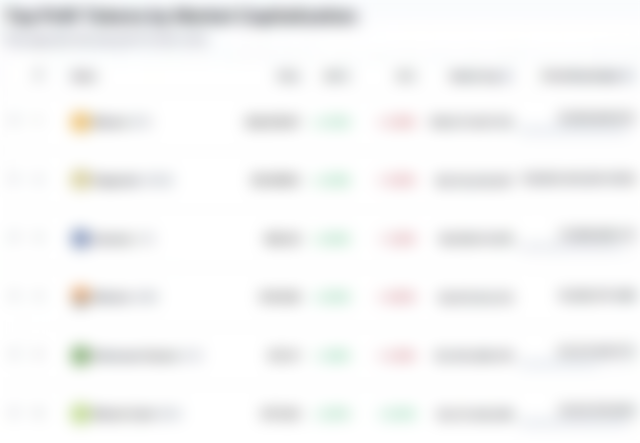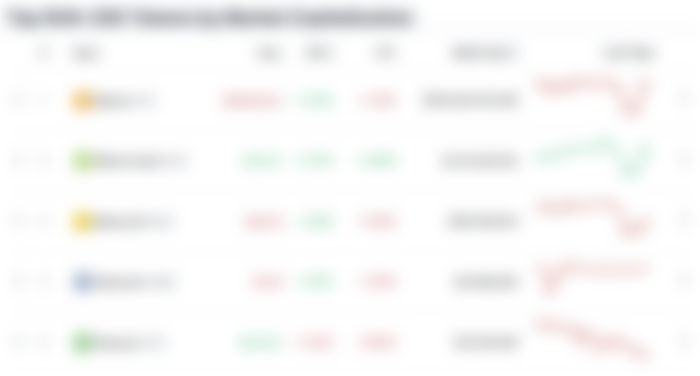The Top COINS That Will Dominate As The SEC Reshuffles The Deck
The End Of The VC-driven Tokens?

With the latest lawsuits against Binance and Coinbase, the SEC sends a clear warning to exchanges about their practices and “offerings”.
In addition, the Commission proceeds with a significant judgment that will shake up the cryptocurrency market.
The SEC made it clear: tokens Are Securities.
Indeed, pre-mined/pre-minted tokens with ICOs, presales, and a private company governing them can’t be called anything else.
The SEC decided that several (if not all) tokens are classified as securities.
Tokens like Solana, Cardano, Atom, Filecoin, SAND, MANA, Algorand, Axie, DASH, and TRX, among several others, are securities.
Which cryptocurrencies fall under the category of commodities (or currencies) rather than securities?
Proof-of-Work cryptocurrencies: COINS.
PoW Cryptocurrencies Will Dominate Cryptocurrency Again

Source: Coinmarketcap
Here are the five cryptocurrencies that matter:
Bitcoin (BTC)
Bitcoin Cash (BCH)
Litecoin (LTC)
Dogecoin (DOGE)
Monero (XMR)
Of course, Bitcoin (BTC) is still the leader, and the only one challenging it in the last three years was Ethereum. However, Ethereum’s transition to Proof-of-Stake consensus already casts doubts.
Proof-Of-Work

Cryptocurrencies operating with Proof-of-Work to achieve distributed consensus use various cryptographic algorithms.
SHA 256: Bitcoin (BTC) and Bitcoin Cash (BCH)

Source: Coinmarketcap
Bitcoin (BTC) and Bitcoin Cash (BCH) utilize SHA256 and secp256k1 Elliptic Curve for private and public keys’ cryptography.
Mining (PoW) in these two cryptocurrencies is performed at an industrial level with farms utilizing specific hardware (ASIC miners) with the sole purpose to solve the SHA256 algorithm and mining new blocks.
Miners fill their blocks with transactions from the mempool. The first transaction on each block is the coinbase transaction, which contains the miners’ reward, the new Bitcoins.
Moreover, miners get to keep all the fees included in the transactions they select in the block.
After miners finish building their block, they enter a race and compete with several other miners working on their block. The miner that first solves the SHA256 puzzle is the one that mines the new block.
This new block is propagated on the network and validated by the rest participants. If the new block follows the current consensus rules (a set of rules regarding the structure of the block and the transactions), the network validates it as the new block. (Block propagation is the time a block requires to reach the majority of nodes).
Immediately after 51% of nodes validate the new block, miners scrap their previous blocks that were not mined and begin work on the next one.
Mining difficulty increases as more participants join with a process dubbed difficulty adjustment.
In Bitcoin (BTC), difficulty adjusts every 2016 blocks.
Bitcoin Cash uses the Difficulty Adjustment Algorithm, which adjusts the difficulty of every day instead.
Scrypt: Litecoin (LTC) And Dogecoin (DOGE)

Source: Coinmarketcap
Litecoin utilizes Scrypt as a hashing algorithm (not SHA256).
SHA256 ASIC equipment used for Bitcoin (BTC) and Bitcoin Cash (BCH) are incompatible with Litecoin mining.
However, ASIC manufacturers produce and sell ASICs modified to solve the Scrypt algorithm.
While Litecoin’s hashrate is extremely low (99% lower than Bitcoin Cash), comparing hashrate with uneven cryptography is not a valid approach to define network security.
Both networks are secure and operate flawlessly for several years.
Dogecoin is mined in parallel to Litecoin. Miners merge mine Litecoin and Dogecoin simultaneously.
Thus Dogecoin enjoys the security of Litecoin, while in fact hashrate is nowhere near Bitcoin (BTC) or Bitcoin Cash (BCH) as almost no other cryptocurrency uses Scrypt.
Litecoin has no actual competition in Scrypt mining as the rest cryptocurrencies following this consensus model (Carbon, Reddcoin, Einsteinium) have lost any appeal they had in 2017 and fallen into irrelevancy.
Other Networks
Monero is currently utilizing RandomX as a mining algorithm since 2019 (ASIC Resistant), aiming to prevent mining farms with specialized hardware from dominating the network.
Some PoW networks like BSV, Ethereum Classic, Monacoin, and Bitcoin Gold have sustained in the past 51%-attacks that damaged their credibility and reputation. Still, ETC and BSV survived. While ETC seems to have a dozen of people following it, max, BSV is more organized but also appears to be fully centralized, with nChain dominating the network.
We want to avoid centralization of power and the possibility of control as much as possible. Complete decentralization is still not achievable, but communities that strive to promote it in all sections of the blockchain and upgrade/scale the networks following what the latest technology suggests, stand at the top of our list.
The SEC Is Not A Friend
The SEC employs a process called the “Howey Analysis” to classify assets as securities or commodities.
Don’t bother with what the SEC thinks or what analysis suggests if a cryptocurrency is a security or a commodity.
The SEC is not a friend of any cryptocurrency. Instead, it plans to obstruct financial innovation and supports the financial hazard called CBDCs. SEC is a tool of the legacy financial establishment.
The SEC will attack anything it can but will not allocate funds, time, and effort to pointlessly attack decentralized networks.
ICOs, presales, pre-mints, and various crypto schemes are now officially considered securities, and the companies that operate them have to abide by the SEC regulations.
There is a clear distinction here between cryptocurrencies, one that has to do with decentralized cryptocurrencies, and those driven by a private company behind them or controlled by a team.
Most PoS networks are entirely centralized, with private companies controlling them. They sell an illusion of decentralization, but facts beg to differ.
The only question is about XRP, which the SEC already labeled as a security, but there is a legal battle going on, and the decision is not official yet. Still, Ripple sold billions upon billions of pre-minted XRP tokens (with no Proof-of-Work) it controlled. Ripple controls more than half of the XRP supply, selling them in small amounts whenever there is demand.
Lastly, the SEC seems to be hesitant about Ethereum. If it were to classify Ethereum as a security, that would define Proof-of-Stake (PoS) in total.
Closing Thoughts
“We don’t need more digital currency. We already have digital currency. It’s called the U.S. dollar. It’s called euro. It’s called the yen. They’re all digital now,”
-Garry Gensler
We can have as many cryptocurrencies as we want, but we already apprehend that centralized pre-mined tokens and the VCs backing them are not the solution.
The SEC can’t press charges against Bitcoin (BTC), Bitcoin Cash (BCH), Monero (XMR) or Litecoin, and Dogecoin.
Centralization is a point of failure.
Decentralized networks out of SEC’s reach that remain secure and reliable will outlive such aggression by representatives of legacy finance.
Starting from there, we can examine each of the top PoW cryptocurrencies in detail, research the intentions of their communities and the decentralization aspect, and find out if they are developing to meet what the world demands: low-cost, instant, and censorship-resistant financial transactions.
The signs of price suppression of working networks will fade away as top crypto exchanges will stop manipulating the market with scams and VC-funded offerings, or pump and dumps of unregistered securities and questionable ethos.
Coinbase will delist several of these tokens that the SEC anointed as securities. The Binance situation is way worse since the SEC has asked the court to freeze and repatriate Binance assets.
The only part of cryptocurrency that matters is decentralization, not just in Proof-Of-Work mining, but also in developments with no team of developers, and no private entity controlling the fate of a network.
The VC-funded centralized networks selling pre-minted tokens and dreams of decentralization never made sense.

Cover Picture On Pixabay by DeltaWorks
My Platforms:
● read.cash ● noise.app ● Medium ● Medium ● Hive ● Steemit ● Vocal
● Publish0x ● Twitter ● CashRain ● Me.dm
Don’t forget to Subscribe and Like if you enjoyed this article!








Really good